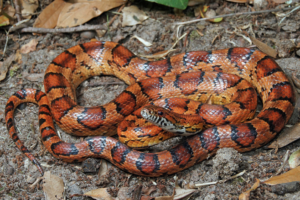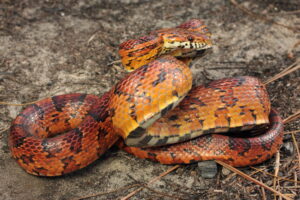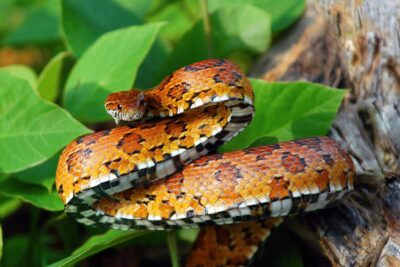Corn snakes, with their vibrant colors and docile demeanor, are popular reptile pets cherished by enthusiasts worldwide. As inquisitive minds delve into the intricacies of these fascinating creatures, one question often emerges at the forefront: “Do corn snakes have fangs?”
No, corn snakes do not have fangs. They are non-venomous snakes and rely on constriction to subdue their prey. Their teeth are small and more like hooks, used for gripping their food rather than injecting venom.
This is in contrast to venomous snakes like vipers (rattlesnakes, copperheads etc.) that have fangs specifically designed to deliver venom.
Do corn snakes have fangs?

Corn snakes absolutely do not have fangs. Here’s why they don’t need them and what they use instead:
-
Non-venomous: Corn snakes are constrictors, meaning they overpower their prey by squeezing it tightly until it suffocates. Venom isn’t necessary for their hunting style.
-
Small teeth: Instead of fangs, corn snakes have small, sharp teeth that act like hooks. These tiny hooks help them grab onto their prey and hold it while they constrict it.
-
Different jaw structure: Fangs are modified teeth with a hollow core that connects to a venom gland. Corn snakes lack this specialized jaw structure and venom glands entirely.
This distinction between fangs and constrictor teeth is important. It helps identify potentially dangerous venomous snakes from harmless constrictors like corn snakes.
Types of fangs found in different snake species
Snakes exhibit a fascinating array of dental adaptations, with fangs being among the most prominent features. Here are some types of fangs found in different snake species:
- Fixed Fangs: These are found in rear-fanged snakes, such as boomslangs and vine snakes. The fangs are located at the back of the mouth and are relatively small compared to those of front-fanged snakes. Rear-fanged snakes typically use their venom for subduing prey rather than self-defense.
- Grooved Fangs: Commonly seen in colubrid snakes like the garter snake, grooved fangs are small, rigid teeth with a groove along their length. While they are not capable of injecting venom deeply, the groove aids in venom delivery when the snake bites down on prey.
- Hollow Fangs: Hollow or tubular fangs are characteristic of front-fanged snakes, which include some of the most venomous species such as vipers, cobras, and rattlesnakes. These fangs are hinged and can be folded against the roof of the mouth when not in use. When biting, venom is injected through the hollow fangs into the prey, aiding in immobilization and digestion.
- Proteroglyphous Fangs: These are fixed, hollow fangs found in the front of the upper jaw of certain venomous snakes, like cobras and coral snakes. Proteroglyphous fangs are usually shorter than solenoglyphous fangs (seen in vipers) and are not capable of extensive movement.
- Solenoglyphous Fangs: Solenoglyphous fangs are the longest and most specialized type of fangs, found in vipers and pit vipers. They are long, hollow, and can be rotated or folded when not in use. This allows the snake to deliver venom deep into the tissues of its prey, aiding in efficient prey immobilization and digestion.
Understanding the diversity of fang types across snake species provides insight into their evolutionary adaptations and ecological roles in different habitats and ecosystems.
Corn Snake Dental Structure

Corn snakes, like many non-venomous snakes, have a unique dental structure suited for their feeding habits. While they lack true fangs, corn snakes possess specialized teeth adapted for grasping and consuming their prey. Here’s an overview of the dental structure of corn snakes:
- Recurved Teeth: Corn snakes have rows of small, recurved teeth lining their upper and lower jaws. These teeth are sharp and pointed, allowing the snake to grip and hold onto its prey securely. While not as prominent as the fangs of venomous snakes, these teeth are essential for the snake’s feeding strategy.
- Constriction: Rather than relying on venom to subdue their prey, corn snakes use constriction as their primary hunting technique. Once they have grasped their prey with their teeth, they wrap their bodies around it and apply pressure, suffocating the prey before consuming it whole.
- Prey Items: Corn snakes are opportunistic feeders and primarily consume small rodents, birds, eggs, and occasionally other reptiles. Their dental structure is well-suited for gripping and consuming these types of prey, enabling them to maintain a diverse diet in their natural habitat.
- Dental Replacement: Like all snakes, corn snakes continuously shed and replace their teeth throughout their lives. This process ensures that their teeth remain sharp and functional for capturing and consuming prey effectively.
Corn Snakes’ Bite Mechanism
The bite mechanism of corn snakes is fascinating and effective, despite lacking the prominent fangs of venomous snakes. Here’s an overview of how corn snakes utilize their dental structure in their bite:
- Grasping: When a corn snake strikes at its prey, it opens its mouth wide and extends its jaw to engulf the prey item. The sharp, recurved teeth lining the upper and lower jaws act like miniature hooks, securely grasping onto the prey.
- Securing Prey: Once the prey is captured, the corn snake contracts its muscles to coil around the prey, holding it firmly in place. This constriction not only prevents the prey from escaping but also aids in suffocation, as the snake gradually tightens its grip.
- Swallowing: With the prey securely held in its jaws, the corn snake begins the process of swallowing. Due to the snake’s flexible jaw structure and the absence of a sternum, it can stretch its mouth around prey items much larger than its own head diameter.
- Digestion: After swallowing the prey whole, the corn snake’s digestive enzymes break down the food in its stomach. Because corn snakes lack venom, they rely solely on constriction and digestion to subdue and consume their prey.
The bite mechanism of corn snakes showcases their adaptability as efficient predators, utilizing their specialized dental structure and powerful muscles to capture, subdue, and consume a variety of prey items. While they may not possess the fearsome fangs of venomous snakes, corn snakes are formidable hunters in their own right, relying on their unique feeding strategies to thrive in their natural habitat.
Conclusion
While corn snakes do not possess fangs in the traditional sense, they do have specialized dental structures tailored to their hunting and feeding needs. With rows of sharp, recurved teeth, corn snakes effectively grasp and subdue their prey through constriction rather than venom injection. This adaptation highlights their evolutionary prowess as efficient predators in their ecosystem.
So, while the absence of fangs distinguishes them from venomous counterparts, corn snakes are nonetheless adept hunters, relying on their unique bite mechanism to thrive in their natural environment.
Thus, the question “Do corn snakes have fangs” prompts a nuanced exploration of their dental anatomy and predatory behavior, revealing the fascinating adaptations that define these captivating reptiles.

